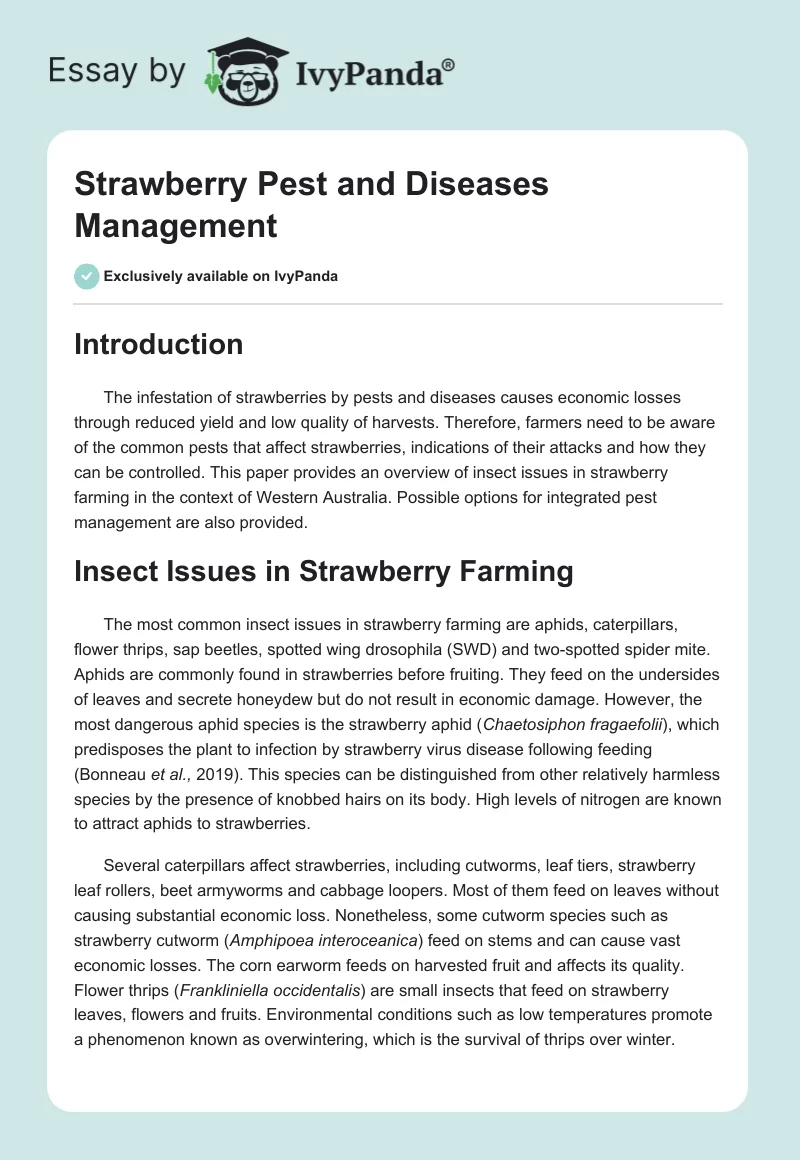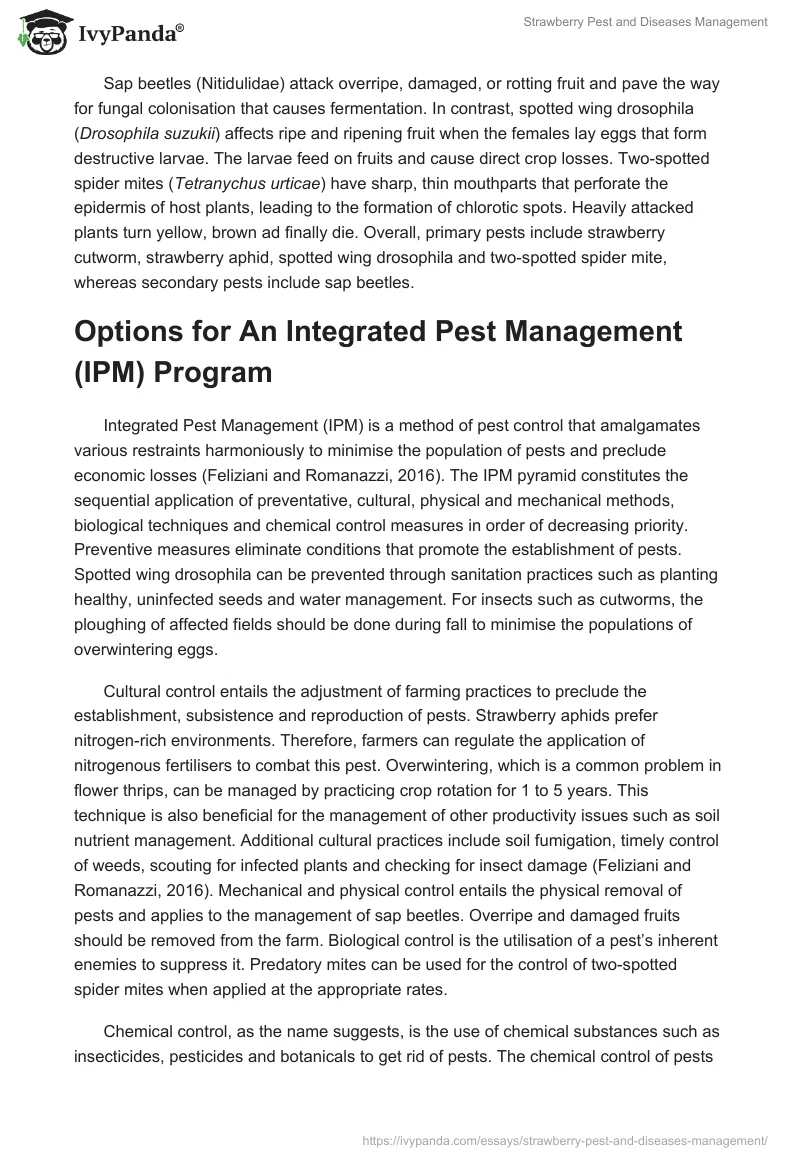Introduction
The infestation of strawberries by pests and diseases causes economic losses through reduced yield and low quality of harvests. Therefore, farmers need to be aware of the common pests that affect strawberries, indications of their attacks and how they can be controlled. This paper provides an overview of insect issues in strawberry farming in the context of Western Australia. Possible options for integrated pest management are also provided.
Insect Issues in Strawberry Farming
The most common insect issues in strawberry farming are aphids, caterpillars, flower thrips, sap beetles, spotted wing drosophila (SWD) and two-spotted spider mite. Aphids are commonly found in strawberries before fruiting. They feed on the undersides of leaves and secrete honeydew but do not result in economic damage. However, the most dangerous aphid species is the strawberry aphid (Chaetosiphon fragaefolii), which predisposes the plant to infection by strawberry virus disease following feeding (Bonneau et al., 2019). This species can be distinguished from other relatively harmless species by the presence of knobbed hairs on its body. High levels of nitrogen are known to attract aphids to strawberries.
Several caterpillars affect strawberries, including cutworms, leaf tiers, strawberry leaf rollers, beet armyworms and cabbage loopers. Most of them feed on leaves without causing substantial economic loss. Nonetheless, some cutworm species such as strawberry cutworm (Amphipoea interoceanica) feed on stems and can cause vast economic losses. The corn earworm feeds on harvested fruit and affects its quality. Flower thrips (Frankliniella occidentalis) are small insects that feed on strawberry leaves, flowers and fruits. Environmental conditions such as low temperatures promote a phenomenon known as overwintering, which is the survival of thrips over winter.
Sap beetles (Nitidulidae) attack overripe, damaged, or rotting fruit and pave the way for fungal colonisation that causes fermentation. In contrast, spotted wing drosophila (Drosophila suzukii) affects ripe and ripening fruit when the females lay eggs that form destructive larvae. The larvae feed on fruits and cause direct crop losses. Two-spotted spider mites (Tetranychus urticae) have sharp, thin mouthparts that perforate the epidermis of host plants, leading to the formation of chlorotic spots. Heavily attacked plants turn yellow, brown ad finally die. Overall, primary pests include strawberry cutworm, strawberry aphid, spotted wing drosophila and two-spotted spider mite, whereas secondary pests include sap beetles.
Options for An Integrated Pest Management (IPM) Program
Integrated Pest Management (IPM) is a method of pest control that amalgamates various restraints harmoniously to minimise the population of pests and preclude economic losses (Feliziani and Romanazzi, 2016). The IPM pyramid constitutes the sequential application of preventative, cultural, physical and mechanical methods, biological techniques and chemical control measures in order of decreasing priority. Preventive measures eliminate conditions that promote the establishment of pests. Spotted wing drosophila can be prevented through sanitation practices such as planting healthy, uninfected seeds and water management. For insects such as cutworms, the ploughing of affected fields should be done during fall to minimise the populations of overwintering eggs.
Cultural control entails the adjustment of farming practices to preclude the establishment, subsistence and reproduction of pests. Strawberry aphids prefer nitrogen-rich environments. Therefore, farmers can regulate the application of nitrogenous fertilisers to combat this pest. Overwintering, which is a common problem in flower thrips, can be managed by practicing crop rotation for 1 to 5 years. This technique is also beneficial for the management of other productivity issues such as soil nutrient management. Additional cultural practices include soil fumigation, timely control of weeds, scouting for infected plants and checking for insect damage (Feliziani and Romanazzi, 2016). Mechanical and physical control entails the physical removal of pests and applies to the management of sap beetles. Overripe and damaged fruits should be removed from the farm. Biological control is the utilisation of a pest’s inherent enemies to suppress it. Predatory mites can be used for the control of two-spotted spider mites when applied at the appropriate rates.
Chemical control, as the name suggests, is the use of chemical substances such as insecticides, pesticides and botanicals to get rid of pests. The chemical control of pests in strawberries applies to the management of insects such as flower thrips. The application of insecticides should be timed and done near peak flights to limit their persistence. Furthermore, farmers should avoid using the same insecticide for consecutive seasons and practice rotation because of the limited number of active ingredients that kill flower thrips. Chemical sprays such as foliar sprays can be used for the management of sap beetles when mechanical control is ineffective (Dara, 2020). Regular chemical applications may also be needed for the management of spotted wing drosophila. Miticides can be used for the control of two-spotted spider mites when their populations reach economic thresholds. Farmers should keep records of pesticides, including date of application, target pest, name of the pesticide, application rate and area covered.
Viability of the IPM Program
The main goals of IPM are economic feasibility, social tolerability and infinitesimal risk to the surroundings and human health. Therefore, chemical controls should only be used when the insect pests reach economic thresholds and when other methods of control are ineffective. The proposed IPM options are feasible because chemical pesticides are only suggested to support other control measures. This approach ensures a more effective, longstanding management of pests.
Conclusion
Integrated pest management helps farmers to minimise economic losses while safeguarding the environment. Proper farming practices and vigilance can protect against economic losses in strawberry farming. Knowledge of distinguishing features of specific pests and susceptible plant stages is critical to the successful application of IPM. As much as chemical controls are effective in the elimination of many insects, their environmental damage dictates that they should be considered as a last resort.
Reference List
- Bonneau, P. et al. (2019) ‘Evaluation of various sources of viral infection in strawberry fields of Quebec, Canada’, Journal of Economic Entomology, 112(6), pp. 2577-2583.
- Dara, S.K. (2020) ‘Implementation of IPDM in strawberries and other berries’, in Gullino, M. et al. (eds.) Integrated pest and disease management in greenhouse crops. Plant Pathology in the 21st Century (9 vols.). New York: Springer, pp. 597-624.
- Feliziani, E. and Romanazzi, G. (2016) ‘Postharvest decay of strawberry fruit: epidemiology, and disease management’, Journal of Berry Research, 6(1), pp. 47-63.


